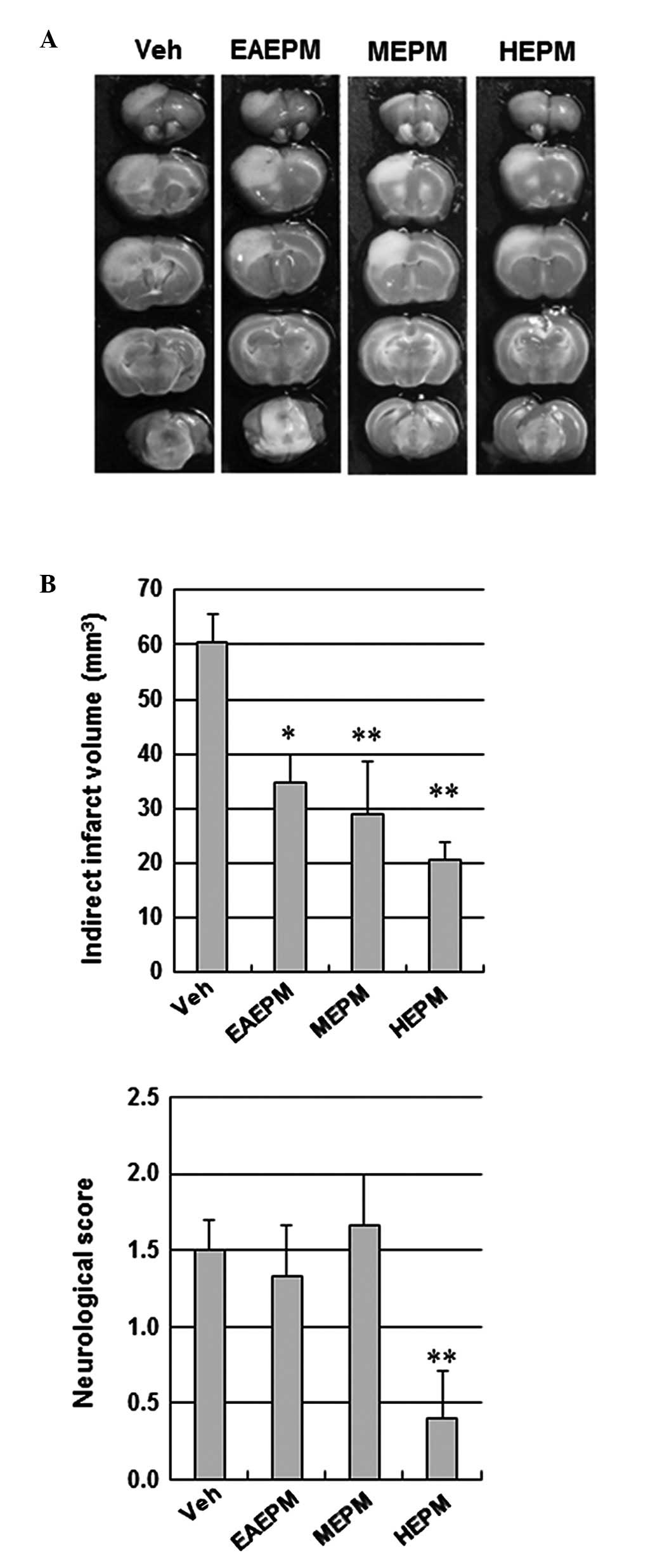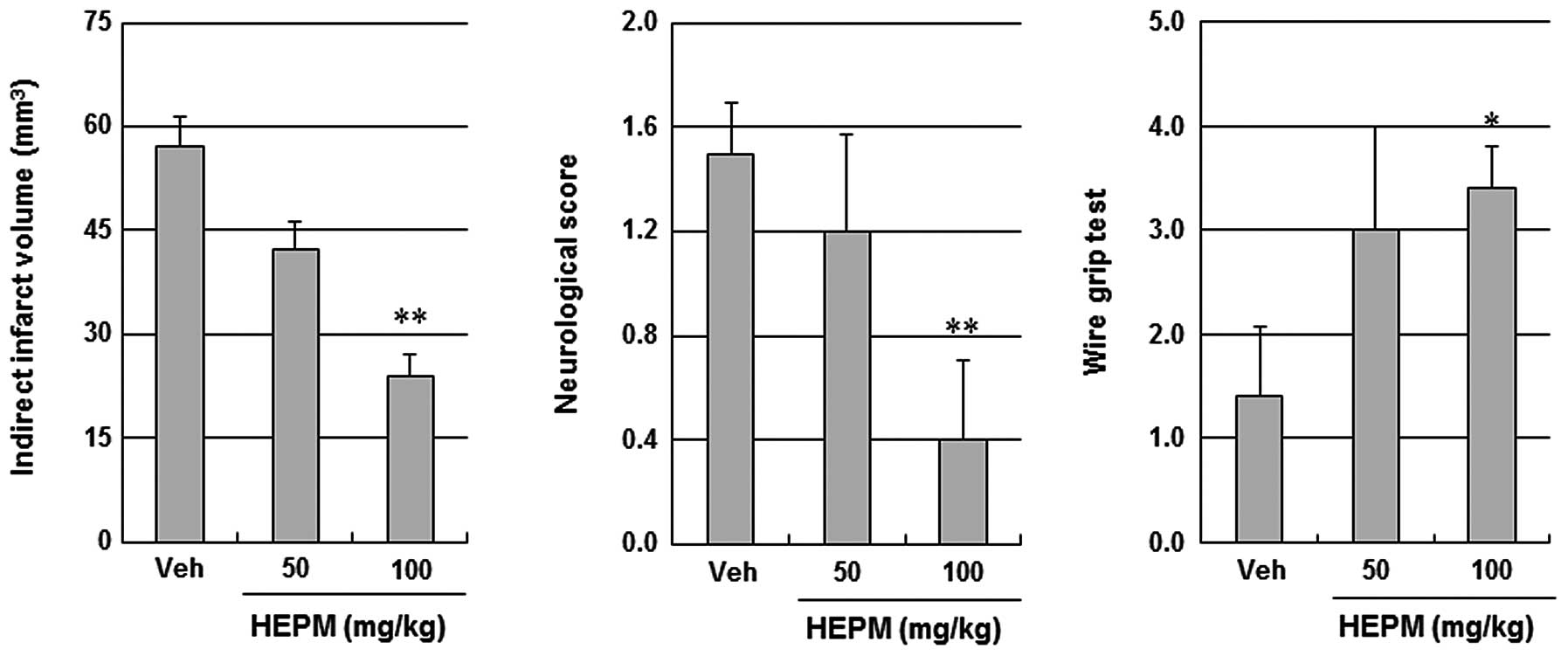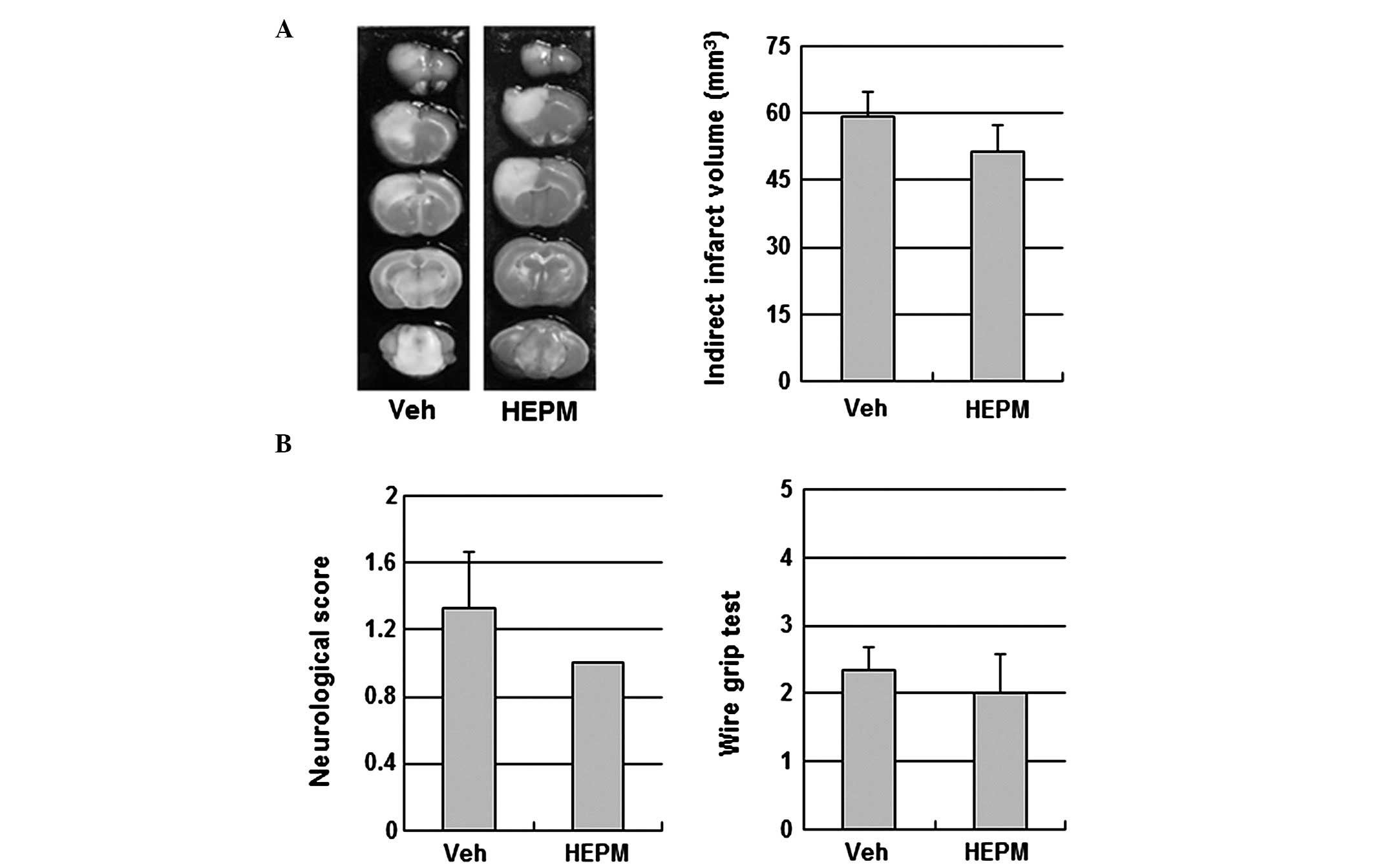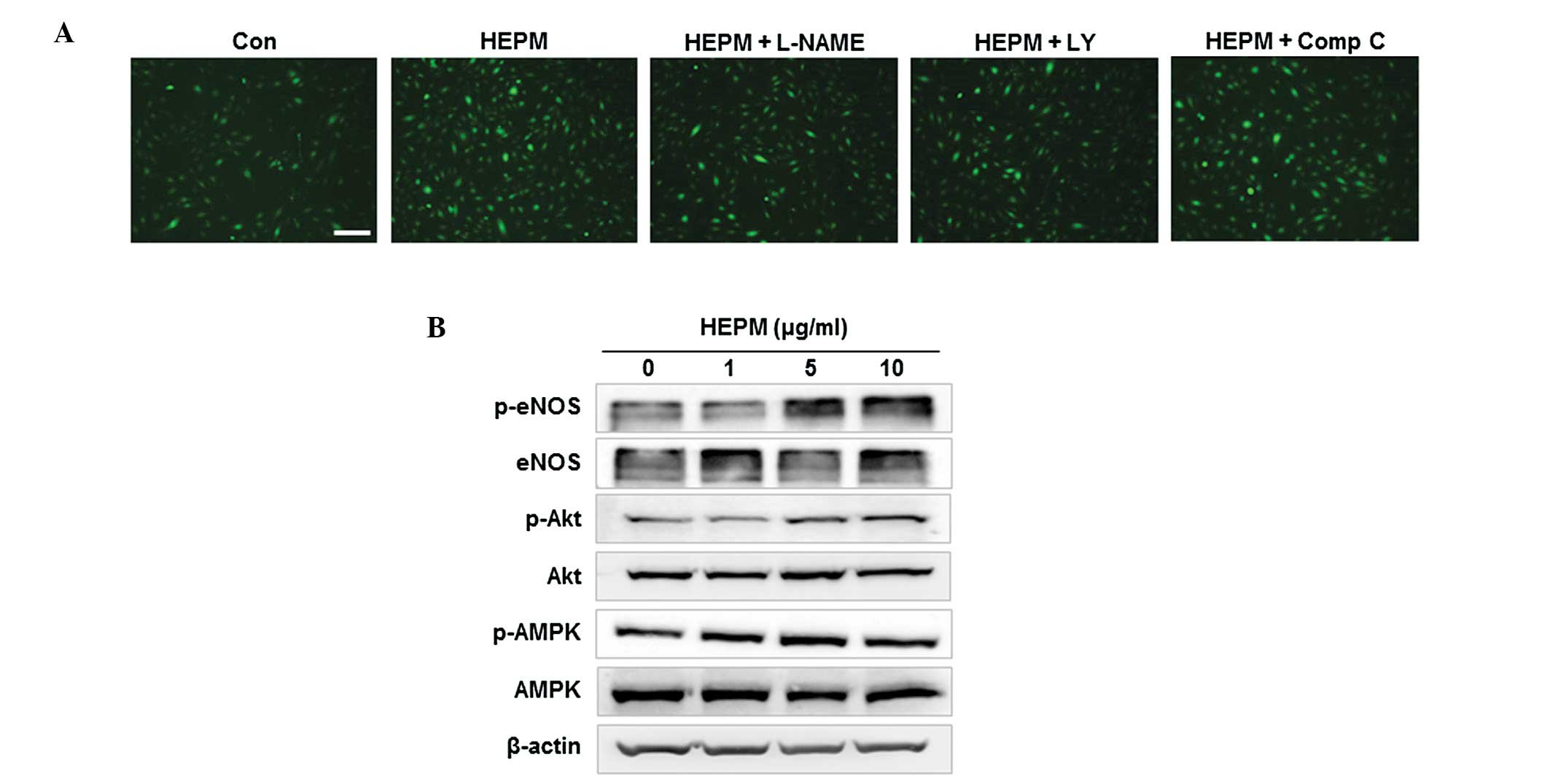|
1
|
Roger VL, Go AS, Lloyd-Jones DM, et al:
Heart disease and stroke statistics - 2011 update: a report from
the American Heart Association. Circulation. 123:e18–e209. 2011.
View Article : Google Scholar : PubMed/NCBI
|
|
2
|
Allen CL and Bayraktutan U: Risk factors
for ischaemic stroke. Int J Stroke. 3:105–116. 2008. View Article : Google Scholar : PubMed/NCBI
|
|
3
|
Endres M, Laufs U, Liao JK and Moskowitz
MA: Targeting eNOS for stroke protection. Trends Neurosci.
27:283–289. 2004. View Article : Google Scholar : PubMed/NCBI
|
|
4
|
Dimmeler S, Fleming I, Fisslthaler B,
Hermann C, Busse R and Zeiher AM: Activation of nitric oxide
synthase in endothelial cells by Akt-dependent phosphorylation.
Nature. 399:601–605. 1999. View
Article : Google Scholar : PubMed/NCBI
|
|
5
|
Limbourg FP, Huang Z, Plumier JC, et al:
Rapid nontranscriptional activation of endothelial nitric oxide
synthase mediates increased cerebral blood flow and stroke
protection by corticosteroids. J Clin Invest. 110:1729–1738. 2002.
View Article : Google Scholar
|
|
6
|
Xiao PG, Xing ST and Wang LW:
Immunological aspects of Chinese medicinal plants as antiageing
drugs. J Ethnopharmacol. 38:167–175. 1993.PubMed/NCBI
|
|
7
|
Liu Z, Liu Y, Chao Z, Song Z, Wang C and
Lu A: In vitro antioxidant activities of maillard reaction products
produced in the steaming process of Polygonum multiflorum root. Nat
Prod Commun. 6:55–58. 2011.PubMed/NCBI
|
|
8
|
Yang PY, Almofti MR, Lu L, et al:
Reduction of atherosclerosis in cholesterol-fed rabbits and
decrease of expressions of intracellular adhesion molecule-1 and
vascular endothelial growth factor in foam cells by a water-soluble
fraction of Polygonum multiflorum. J Pharmacol Sci. 99:294–300.
2005. View Article : Google Scholar
|
|
9
|
Um MY, Choi WH, Aan JY, Kim SR and Ha TY:
Protective effect of Polygonum multiflorum Thunb on amyloid
beta-peptide 25–35 induced cognitive deficits in mice. J
Ethnopharmacol. 104:144–148. 2006.PubMed/NCBI
|
|
10
|
Chan YC, Wang MF and Chang HC: Polygonum
multiflorum extracts improve cognitive performance in senescence
accelerated mice. Am J Chin Med. 31:171–179. 2003. View Article : Google Scholar : PubMed/NCBI
|
|
11
|
Wang T, Gu J, Wu PF, et al: Protection by
tetrahydroxystilbene glucoside against cerebral ischemia:
involvement of JNK, SIRT1, and NF-kappaB pathways and inhibition of
intracellular ROS/RNS generation. Free Radic Biol Med. 47:229–240.
2009. View Article : Google Scholar : PubMed/NCBI
|
|
12
|
Sun FL, Zhang L, Zhang RY and Li L:
Tetrahydroxystilbene glucoside protects human neuroblastoma SH-SY5Y
cells against MPP+-induced cytotoxicity. Eur J
Pharmacol. 660:283–290. 2011. View Article : Google Scholar : PubMed/NCBI
|
|
13
|
Lee JK, Park MS, Kim YS, et al:
Photochemically induced cerebral ischemia in a mouse model. Surg
Neurol. 67:620–625. 2007. View Article : Google Scholar : PubMed/NCBI
|
|
14
|
Li X, Blizzard KK, Zeng Z, DeVries AC,
Hurn PD and McCullough LD: Chronic behavioral testing after focal
ischemia in the mouse: functional recovery and the effects of
gender. Exp Neurol. 187:94–104. 2004. View Article : Google Scholar : PubMed/NCBI
|
|
15
|
Chen T, Liu W, Chao X, et al: Salvianolic
acid B attenuates brain damage and inflammation after traumatic
brain injury in mice. Brain Res Bull. 84:163–168. 2011. View Article : Google Scholar : PubMed/NCBI
|
|
16
|
Kojima H, Sakurai K, Kikuchi K, et al:
Development of a fluorescent indicator for nitric oxide based on
the fluorescein chromophore. Chem Pharm Bull (Tokyo). 46:373–375.
1998. View Article : Google Scholar : PubMed/NCBI
|
|
17
|
Fisslthaler B and Fleming I: Activation
and signaling by the AMP-activated protein kinase in endothelial
cells. Circ Res. 105:114–127. 2009. View Article : Google Scholar : PubMed/NCBI
|
|
18
|
Chan YC, Wang MF, Chen YC, Yang DY, Lee MS
and Cheng FC: Long-term administration of Polygonum multiflorum
Thunb. reduces cerebral ischemia-induced infarct volume in gerbils.
Am J Chin Med. 31:71–77. 2003.PubMed/NCBI
|
|
19
|
Jang JY, Kim HN, Kim YR, et al: Hexane
extract from Polygonum multiflorum attenuates glutamate-induced
apoptosis in primary cultured cortical neurons. J Ethnopharmacol.
145:261–268. 2013. View Article : Google Scholar : PubMed/NCBI
|
|
20
|
Dudzinski DM and Michel T: Life history of
eNOS: partners and pathways. Cardiovasc Res. 75:247–260. 2007.
View Article : Google Scholar : PubMed/NCBI
|
|
21
|
Huang Z, Huang PL, Ma J, et al: Enlarged
infarcts in endothelial nitric oxide synthase knockout mice are
attenuated by nitro-L-arginine. J Cereb Blood Flow Metab.
16:981–987. 1996. View Article : Google Scholar : PubMed/NCBI
|
|
22
|
Huang HC, Chu SH and Chao PD:
Vasorelaxants from Chinese herbs, emodin and scoparone, possess
immunosuppressive properties. Eur J Pharmacol. 198:211–213. 1991.
View Article : Google Scholar : PubMed/NCBI
|
|
23
|
Xu XL, Huang YJ, Chen XF, Lin DY and Zhang
W: 2,3,4′,5-tetrahydroxystilbene-2-O-β-D-glucoside inhibits
proliferation of vascular smooth muscle cells: involvement of
NO/cGMP/PKG pathway. Phytother Res. 26:1068–1074. 2012.
|
|
24
|
Zhang W, Xu XL, Wang YQ, Wang CH and Zhu
WZ: Effects of 2,3,4′,5-tetrahydroxystilbene 2-O-beta-D-glucoside
on vascular endothelial dysfunction in atherogenic-diet rats.
Planta Med. 75:1209–1214. 2009.
|
|
25
|
Fulton D, Gratton JP and Sessa WC:
Post-translational control of endothelial nitric oxide synthase:
why isn’t calcium/calmodulin enough? J Pharmacol Exp Ther.
299:818–824. 2001.
|
|
26
|
MacRitchie AN, Jun SS, Chen Z, et al:
Estrogen upregulates endothelial nitric oxide synthase gene
expression in fetal pulmonary artery endothelium. Circ Res.
81:355–362. 1997. View Article : Google Scholar : PubMed/NCBI
|













